The Most Affordable Cuts Of Steak That Taste Seriously Delicious

Few cuts of meat can get as pricey as steak. These slabs of beef are usually the star of the show in fancy restaurants and have the price tag to prove it. The priciest steak in the world, setting customers back $1000 each, is sold at Aragawa, a restaurant in Tokyo, and other cuts like the Kobe ribeye or Maezawa fillet can be priced at hundreds of dollars per portion. Steak prices are usually determined by a combination of quality and tenderness. Meat from a cow reared using high-quality food and ethical farming techniques will cost more to produce, which will be reflected in the price of the steak -- but it will also likely taste way better than meat produced in poorer conditions.
The tenderness of a steak is also determined by the section used, with cuts like tenderloin and filet mignon being prized for their juiciness. But they're far from the only options out there. There are dozens of different types of steak, and beyond the most well-known ones, some underrated cuts deliver big on flavor and won't ruin your weekly budget. We decided to put together some of our favorites right here.
Read more: The 13 Best Steaks For Grilling
Flank Steak
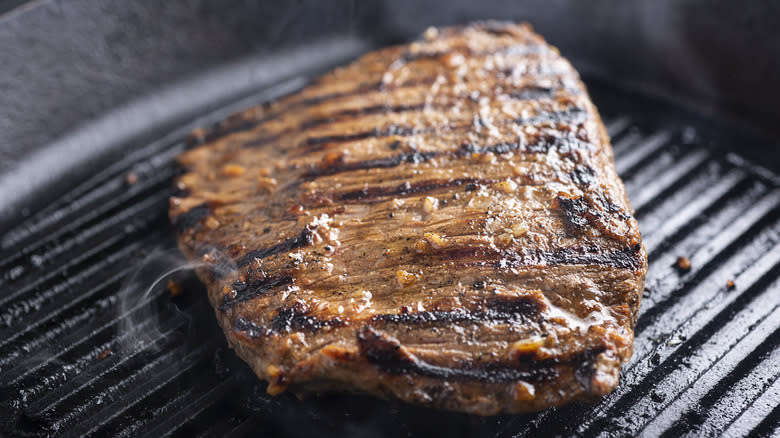
If you need a quick and easy steak for your dinner, go for a flank. You can usually find good-quality flank steak for around $10 per pound, although some flank cuts may be slightly cheaper or more expensive, depending on their quality. Part of the reason why flank steak is cheaper is because it's a thinner cut, which comes from the cow's abdomen. Although this can mean that you get less meat per forkful, it also means that it cooks quicker and takes on the flavors of marinades fast, giving you a juicy result.
Flank steak can be used in many different ways, from being cooked and served whole to sliced and served in sandwiches or tacos. As flank steak can get somewhat tough if you overcook it due to its leanness, it's best to aim for either a really short cooking time or a really long one. Slow-cooking flank steak can cause the muscle fibers to break down considerably, turning what could be a chewy steak into an ultra-soft, tender piece of beef. Conversely, flash-frying or grilling it at high heat allows you to get a good sear on its surface while keeping it rare and juicy.
Chuck Eye
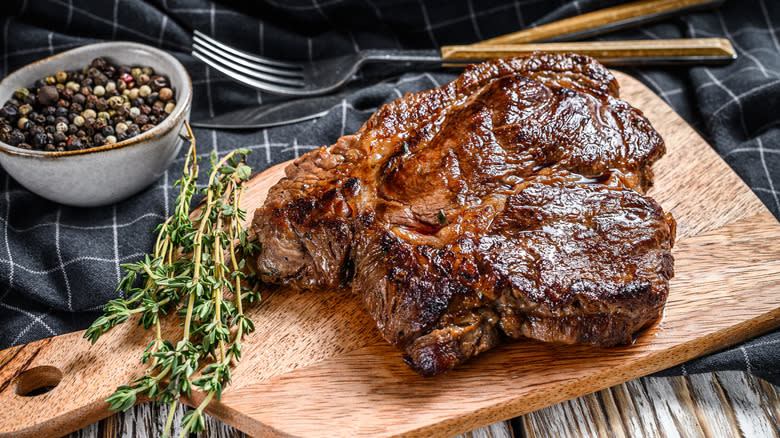
Most people will be more familiar with chuck meat in its ground form. Coming from the shoulder of the cow, chuck can get pretty firm, lending itself to being broken down and used in burgers or meatloaf. But the chuck eye steak, coming from the same section, is a well-kept secret. "The steak gets its nickname because years ago butchers would keep this steak for themselves because it cooked and tasted like a ribeye while being more budget-friendly," says beef supply chain expert Jason Jerome on CNET. "This steak sits right next to the ribeye primal and therefore inherits a lot of the same qualities you would get from a ribeye."
Chuck eye is blessed with a high fat ratio, a relatively rare trait for cheaper cuts, which tend to be lean and tough. This fat gives it additional moisture and stops it drying out when cooked. Chuck eye steaks can be cooked like ribeyes, seared on the stove, and then left to rest. But the cut also reacts well when braised, with its fat melting down until soft, tender, and lubricating the denser muscle fibers.
Flat Iron
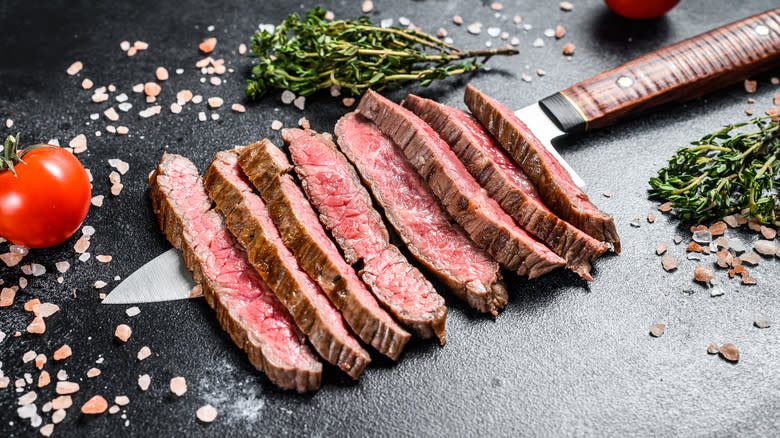
Flat iron steaks have seen a renaissance recently, with increasing amounts of restaurants cottoning on to the flavor they offer for their low cost. But while they may be on the up, this cut still maintains a fairly reasonable price point. Flat iron comes from the shoulder section of the cow, and it has a dense, rich flavor thanks to its good amount of marbling. When cooked, this marbled fat softens the steak from within, preventing it from ending up too chewy.
Thanks to the flat iron's fat content, it's harder to mess up when cooking it, and you can prepare it in pretty much any way you want. Unlike other affordable steak cuts, marinating a flat iron is less necessary, but a short soak in a flavorful mixture can boost its natural beefiness. Grilled flat iron steaks will need roughly 5-6 minutes on each side for a medium-rare result but may need slightly less time if your cut is less than an inch thick. You'll need slightly less time for a pan-fried flat iron -- and if you're going with this method, make sure you use a cast-iron skillet, which will give your meat the best crust.
Skirt Steak
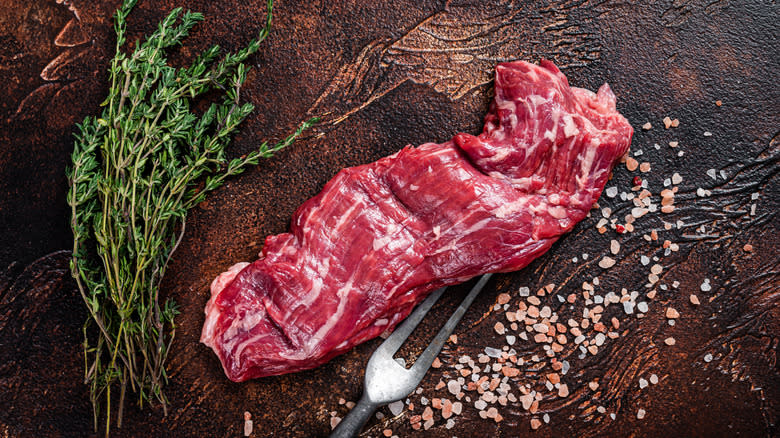
If you need an affordable cut of beef, look no further. Skirt steak is one of the best ways to enjoy steak at a reasonable price, with USDA Choice cuts of Angus beef skirt steak costing around $9 per pound. Coming from the underbelly of the cow, skirt steak is usually pretty long and thin, and it carries a good amount of flavor. Its shape is partly why it's so cheap, as it doesn't have the density that steakhouse cuts usually do. As a result, it can often be ground but is frequently served sliced in fajitas, stir-fries, or cheesesteaks.
Skirt steak has a lot of connective tissue running through it, and this can mean that it's slightly trickier to cook -- and when combined with its thinness, it can easily become dry and dense. But marinating your steak will help to counteract this. Using a marinade with a slightly acidic element, like a squeeze of lemon juice or lactic acid-filled buttermilk, can tenderize the connective tissue and make the meat juicier. Marinating skirt steak is also an excellent way to imbue it with extra flavor before cooking and seasoning it from within.
Strip Steak

It used to be all about the sirloin when it comes to steak. But these days, the strip steak, often dubbed the New York Strip, has really come into vogue. Steakhouses will frequently feature a strip steak, which comes from the loin of the cow. This section of a cow's musculature is generally fairly underused, and this means that the muscle doesn't build up and become dense and, therefore, chewy.
However, while strip steaks are more expensive, there's still a way to get them affordably. The key is to go big and buy the full striploin from your butcher. "With a whole striploin, you can save up to $2 per pound by buying in bulk and cutting down your own strip steaks at home," says Jason Jerome on CNET. "On average, a striploin weighs 14 to 15 pounds, so that could be an average savings of up to $28 to $30." Although some strip steaks will be pricier, it's still possible to find the cut from around $10-15 per pound in some major retailers. Additionally, the strip steak will usually be way cheaper than fellow loin cuts like the tenderloin.
Sirloin
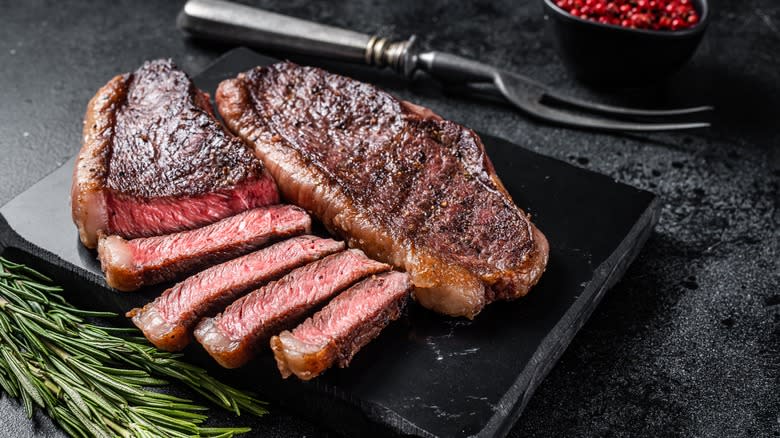
This steak cut is one of the most well-known out there, and it can fetch a pretty steep price in gourmet eateries. But surprisingly, the base price of sirloin steaks is not actually that high. The average price of sirloin steak in the United States was $10.17 per pound in 2022, according to Statista, and this price was almost a dollar lower than the year before. Coming from the cow's loin, the sirloin is a flavorful, thick cut that, when butchered and cooked right, is supremely tender. It has a rich, satisfying flavor, and is usually adjoined by a generous rim of fat, which helps to moisten the tougher meat.
Higher-quality sirloin steaks are best left largely alone and grilled or fried until brown on the outside and pink within. For cheaper sirloins, like the bottom sirloin butt cut, it can be trickier to achieve peak tenderness. These cuts are located in the muscles closer to the cow's leg, which means that they're used more throughout its lifetime and are, therefore, tougher. Bottom sirloin butt cuts are best when stewed or braised for longer periods or flash-fried and then sliced into thin strips so that you don't have to chew through them too much.
Tri-tip
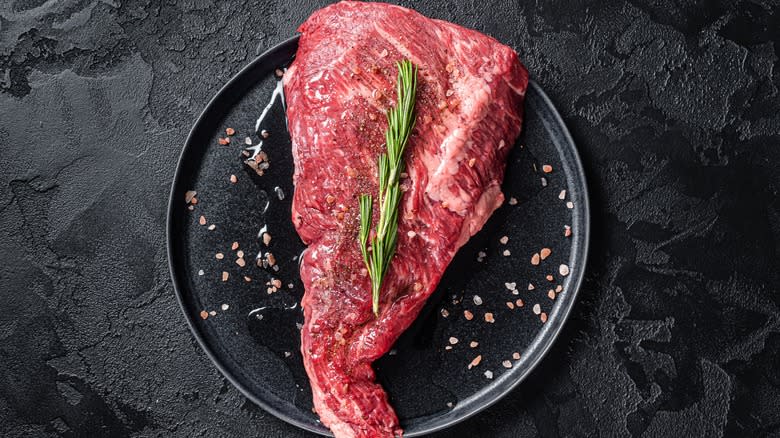
Tri-tip steaks are instantly identifiable, thanks to their unique shape. Hinted at in its name, the tri-tip is a triangular cut of beef, coming from the loin of the animal. Although some restaurants specialize in serving a tri-tip, it remains an underused cut, and as such hasn't had its price inflated, remaining affordable. But it's also a cut that brings a lot of flavor to the table, thanks to the marbling that runs through it, which keeps it from tightening and becoming chewy when cooked.
Tri-tips respond particularly well to broiling and generally cook pretty quickly, taking anywhere from 6-10 minutes on each side for a medium-rare finish, depending on the steak's thickness. As with other steaks, you can also grill them or fry them in a skillet or cube them up for use in stir-fries, stews, or curries, but we recommend saving this method for tougher cuts. Marinating a tri-tip isn't essential, as it will remain moist during its cooking process. If you do opt to do so, though, only soak them for a few hours. Soaking meat for too long in a strongly flavored marinade can break the muscle fibers down way too much, leaving you with unpleasantly soft meat.
Petite Tender
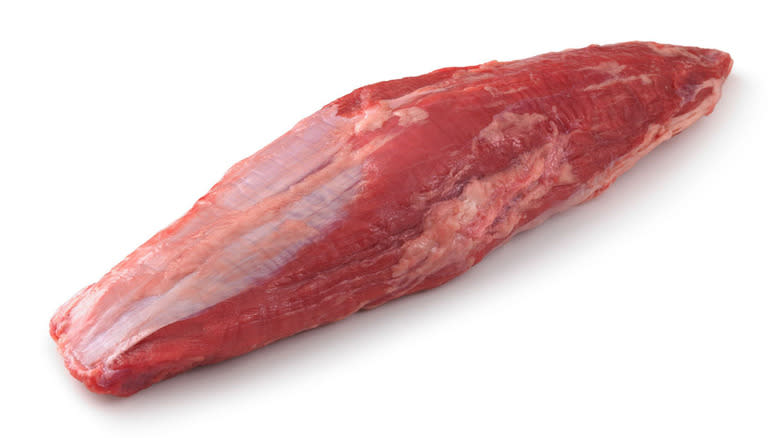
The tenderloin may be a well-known, well-regarded steak, but it is also exceedingly expensive. But there's another tender cut in town, folks. The petite tender is located in the shoulder, or chuck, section of the cow and is an oval-shaped cut comprised mainly of solid muscle with some fat. It's a slightly less common cut, partly because it's pretty difficult to butcher successfully, and as such, is often overlooked in favor of easier-to-retrieve meat. However, this also means that you're usually able to find it at a cheaper price, and it's definitely cheaper than grabbing a tenderloin.
Petite tender cuts are often cut into shoulder medallions and make good individual portions of thick steak. Because of their shape and density, petite tender steaks are best suited to flash-frying and are a particularly good choice for people who like their meat extra rare. A slower cooking process, however, will lead to meat that falls apart easily, with the petite tender faring well in sous vide machines and in slow cookers. Thanks to its high meat-to-fat ratio, this cut is also a great choice for people who are looking for protein without too much grease.
Denver Steak
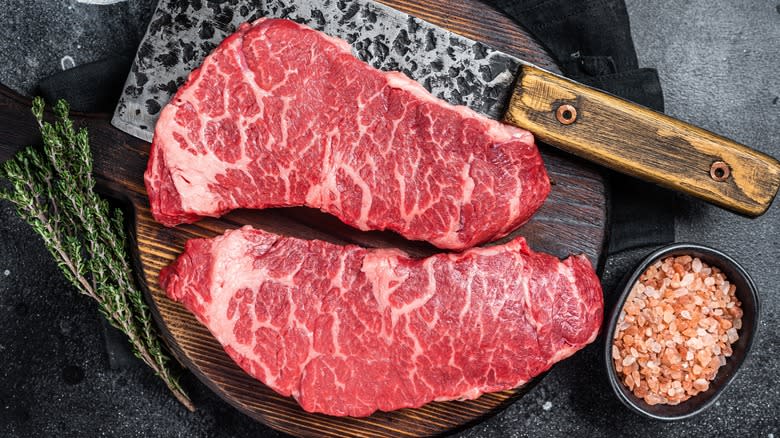
The New York Strip isn't the only steak that's named after a city. Slightly less well-known is the Denver steak, another shoulder cut that's both underused and, in our opinion, underpriced. Denver steaks come from a part of the shoulder section that's less used, resulting in a more tender composition. They also have a good amount of fat marbled throughout the muscle and are usually available in pretty thick cuts.
One downside of Denver steak is that it can be more difficult to locate, and so you may need to head to a butcher's to get it. If you do, you'll be rewarded with a steak cut to your exact specifications. To cook a Denver steak, you'll want to go with the highest heat possible. The idea is to develop a thick, deep-brown crust on the exterior while warming the center up enough so that the fat melts and distributes juices throughout. Make sure you cook the steak whole instead of slicing it first, as this will allow it to retain its moisture. Denver steaks can be marinated, but they're better served by being cooked without and then coated with a herbs or garlic butter.
Merlot Steak
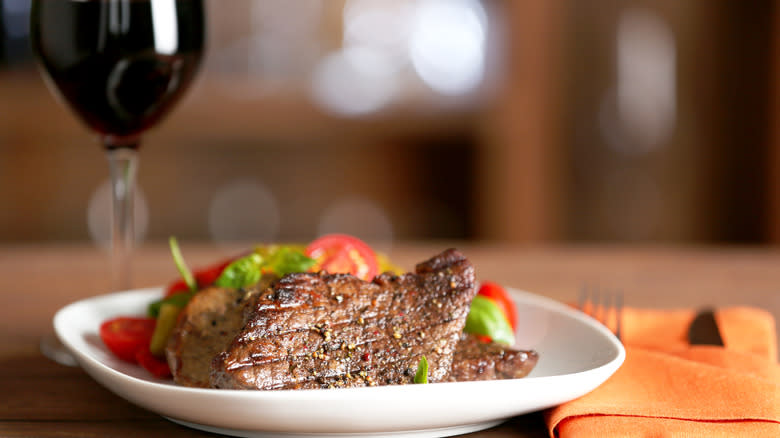
The hind leg section of the cow houses several steak cuts, most of which are fairly lean, thanks to the regular use of these muscles. But lean doesn't necessarily mean tough, and the Merlot steak is a testament to this. The Merlot steak is similar to the flank steak but is usually more tender thanks to being composed of finer muscle fibers. This steak cut's name is reminiscent of its deep-red color and its suitability to be paired with a good glass of your favorite Merlot wine.
While you might find it hard to locate a Merlot steak in a supermarket, butchers will usually sell this cut for a reasonable price. As with other leaner cuts, your method of preparing and cooking this steak is key to your success. Tenderizing a Merlot steak beforehand can be helpful to break down its connective tissue, either by using a marinade or a meat mallet. If using the latter, though, ensure that you don't pound it too vigorously -- Merlot steaks are pretty thin, and tenderizing it too much could cause it to rip. Once you've prepared the steak, aim to cook it quickly using high heat on a grill or in a skillet, and then leave it to rest to let the juices settle.
Beef Shank
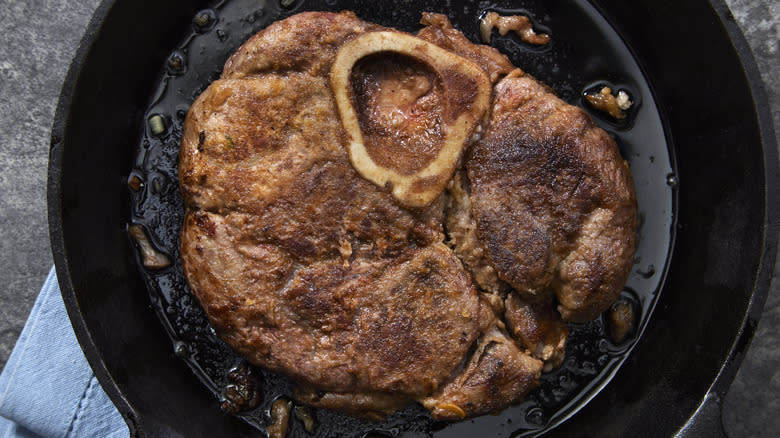
The beef shank is a steak with a difference. Rather than taking the traditional flat, rectangular shape of a sirloin or a flank steak, beef shanks usually come wrapped around the leg bone of the cow, giving them a circular, sometimes quite chunky shape. The leanness of the cut and the awkwardness of having to deal with the bone while cooking and eating have kept beef shanks both cheaply priced and hard to find. Locate them, though, and you'll be rewarded with a deeply flavorful cut of beef for as little as $3 per pound. The bone-in structure of beef shanks also means that you'll be able to take advantage of their marrow, which becomes intensely tasty and rich when cooked.
Their shape makes cooking beef shanks a bit tricky, and frying them can be difficult because the bone is still attached. Instead, you should aim to braise them. Braising beef shanks on a low, consistent temperature for several hours; this cooks the meat until it's practically falling away from the bone and helps to create a flavorful broth or sauce that the marrow contributes to. Using other low-and-slow cooking methods, like sous vide or slow cooking, can deliver similarly tasty results.
Top Round
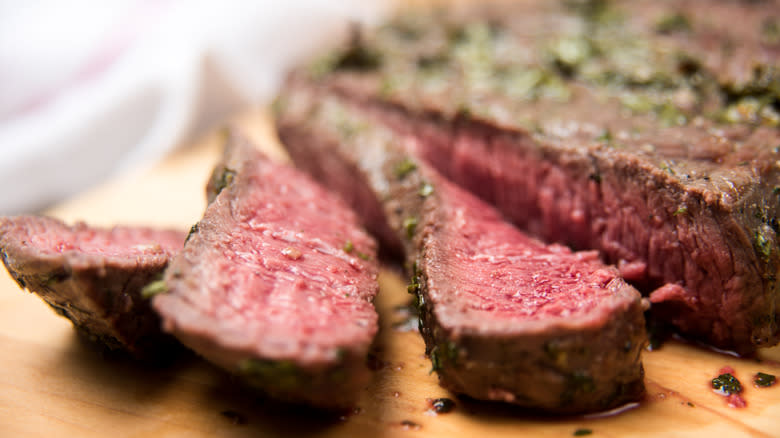
The top round is one of many cuts that come from the back legs of the cow, an area that typically sees its meat ground up due to its relative toughness. In recent years, though, more and more people are realizing that these cuts can produce good-quality steak at rock-bottom prices. Top round, also called the London broil, is perhaps the best choice for folks wanting a classic steak from this region, thanks to its classic steak-like shape and thickness -- and with an average price around $7 per pound, it's a steal. It's also pretty widely available, unlike other cheaper cuts, which can require a trip to a butcher. Thanks to its leanness, it's an excellent cut for delivering protein without too much saturated fat and high levels of iron and zinc.
Top round has a sirloin-like, beefy flavor, but unlike sirloin, it's less well-suited to being pan-fried or grilled. This is because of its low-fat content, which increases the chances of it becoming overly chewy. The same thing can happen if it's cooked at a temperature that's too low for an inadequate amount of time. This steak works particularly well when roasted slowly or as a stewing cut.
Arm Roast
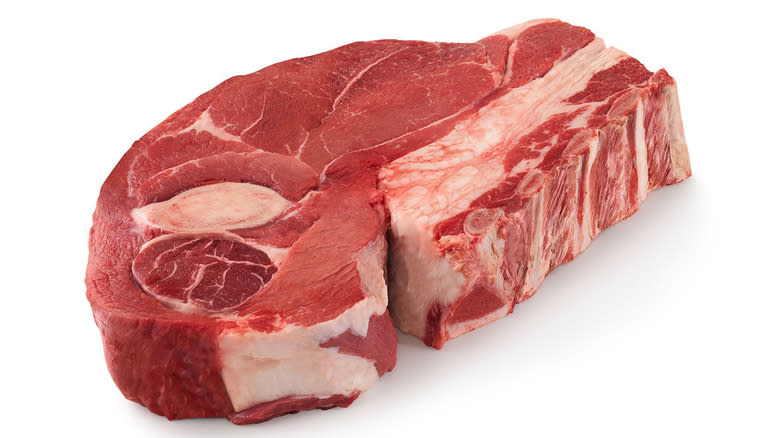
Arm roasts are a great choice for beef on a budget. This cut usually has a price of $5 to $10 per pound in supermarkets, and for that cost, it'll deliver a good amount of flavor. It is located in the chuck section of the animal and tends to be more tender than the closely-located chuck roast, thanks to its lower ratio of connective tissue to meat. The arm roast's composition can vary, with some cuts being especially lean and others having thick veins of fat and connective tissue running through them. It can also contain bones or be totally boneless -- the bone-in versions are usually more common in butcher shops.
Due to the variability of the arm roast, it can be difficult to recommend grilling it, as this can produce varying results. One method you can't go wrong with, though, is pot roasting. A low temperature and long cooking time will ensure that the meat doesn't seize up and that any fat in the beef moistens it. Arm roasts also respond well to bold flavor combinations and good levels of spice, thanks to their meaty, rich taste.
Blade Chuck Steak
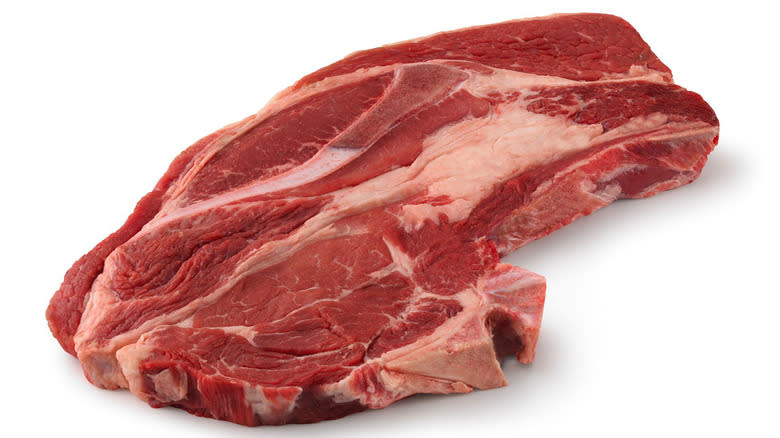
The blade chuck steak can be difficult to find, but those who do will be rewarded. Also known as the boneless blade or the deluxe blade steak, it's a fat cut of beef that, at first glance, can look rather poorly butchered due to the thick, central vein of fat running through it. This fat is part of the blade chuck steak's charm, though, and gives it a serious amount of flavor, which is further boosted by the marbling through the meat.
The somewhat clumsy look of the steak can explain its low price, but when cooked properly, the meat remains juicy. Its fat content also means that, unlike a lot of other cheap cuts of steak, which can be very lean, the blade chuck steak can be used for smoking, its fat keeping it moist while it absorbs the deep, complex flavors. This steak is also great when grilled and is best enjoyed with a simple, sharp marinade or sauce, which can help to cut through the richness of its natural flavor. If desired, you can also trim off some of the fat to make it leaner -- but we'd recommend leaving it just as it is.
Sirloin Flap
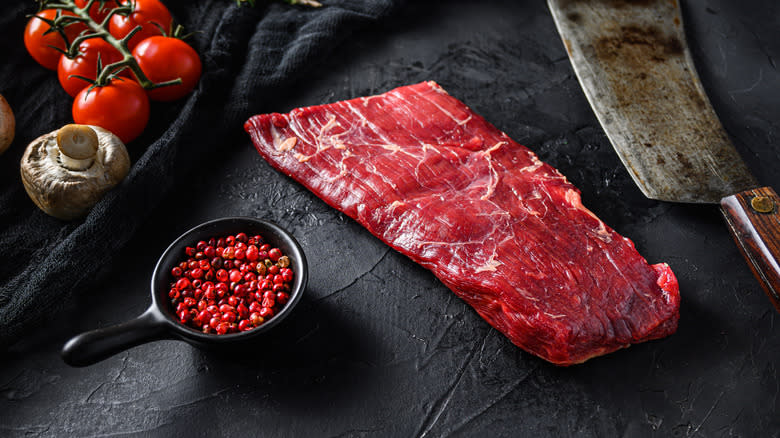
The sirloin flap is sort of like the underappreciated little brother of the classic sirloin. This thin, long strip of meat can seem unimpressive from the bottom of the cut, and its awkward shape is reflected in its lower price. But its excellent ratio of fat to meat and the dotting of the fat throughout the length of the cut ensures that it remains full of flavor and moisture.
The sirloin flap is also known as the sirloin bavette. Fans of the skirt steak or the tri-tip will be impressed with its flavor and ability to withstand various cooking methods. And, indeed, this steak cut is versatile. It can be grilled or fried on its own, sliced and tossed through a salad, stuffed into a cheesesteak, or gently cooked in a crockpot until melt-in-your-mouth tender. Its fat distribution means that it's a solid choice for use in fajitas or other wraps, as the meat will remain well-lubricated, and the spices will be underpinned and mellowed by the deep, fatty flavors.
Read the original article on Daily Meal.

